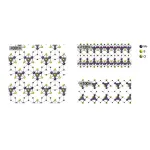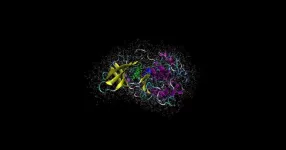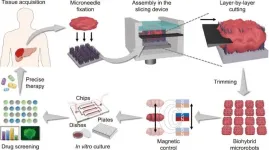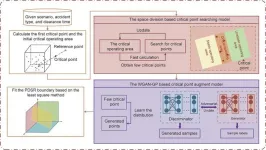(Press-News.org) In a hopeful sign for demand for more safe, effective antibiotics for humans, researchers at The University of Texas at Austin have leveraged artificial intelligence to develop a new drug that already is showing promise in animal trials.
Publishing their results in Nature Biomedical Engineering, the scientists describe using a large language model—an AI tool like the one that powers ChatGPT—to engineer a version of a bacteria-killing drug that was previously toxic in humans, so that it would be safe to use.
The prognosis for patients with dangerous bacterial infections has worsened in recent years as antibiotic-resistant bacterial strains spread and the development of new treatment options has stalled. However, UT researchers say AI tools are game-changing.
“We have found that large language models are a major step forward for machine learning applications in protein and peptide engineering,” said Claus Wilke, professor of integrative biology and statistics and data sciences, and co-senior author of the new paper. “Many use cases that weren’t feasible with prior approaches are now starting to work. I foresee that these and similar approaches are going to be used widely for developing therapeutics or drugs going forward.”
Large language models, or LLMs, were originally designed to generate and explore sequences of text, but scientists are finding creative ways to apply these models to other domains. For example, just as sentences are made up of sequences of words, proteins are made up of sequences of amino acids. LLMs cluster together words that share common attributes (such as cat, dog and hamster) in what’s known as an “embedding space” with thousands of dimensions. Similarly, proteins with similar functions, like the ability to fight off dangerous bacteria without hurting the people who host said bacteria, may cluster together in their own version of an AI embedding space.
“The space containing all molecules is enormous,” said Davies, co-senior author of the new paper. “Machine learning allows us to find the areas of chemical space that have the properties we’re interested in, and it can do it so much more quickly and thoroughly than standard one-at-a-time lab approaches.”
For this project, the researchers employed AI to identify ways to reengineer an existing antibiotic called Protegrin-1 that is great at killing bacteria, but toxic to people. Protegrin-1, which is naturally produced by pigs to combat infections, is part of a subtype of antibiotics called antimicrobial peptides (AMPs). AMPs generally kill bacteria directly by disrupting cell membranes, but many target both bacterial and human cell membranes.
First, the researchers used a high-throughput method they had previously developed to create more than 7,000 variations of Protegrin-1 and quickly identify areas of the AMP which could be modified without losing its antibiotic activity.
Next, they trained a protein LLM on these results so that the model could evaluate millions of possible variations for three features: selectively targeting bacterial membranes, potently killing bacteria and not harming human red blood cells to find those that fell in the sweet spot of all three. The model then helped guide the team to a safer, more effective version of Protegrin-1, which they dubbed bacterially selective Protegrin-1.2 (bsPG-1.2).
Mice infected with multidrug-resistant bacteria and treated with bsPG-1.2 were much less likely to have detectable bacteria in their organs six hours after infection, compared to untreated mice. If further testing offers similarly positive results, the researchers hope eventually to take a version of the AI-informed antibiotic drug into human trials.
“Machine learning’s impact is twofold,” Davies said. “It’s going to point out new molecules that could have potential to help people, and it’s going to show us how we can take those existing antibiotic molecules and make them better and focus our work to more quickly get those to clinical practice.”
This project highlights how academic researchers are advancing artificial intelligence to meet societal needs, a key theme this year at UT Austin, which has declared 2024 the Year of AI.
The study’s other authors are research associate Justin Randall and graduate student Luiz Vieira, both at UT Austin.
Funding for this research was provided by the National Institutes of Health, The Welch Foundation, the Defense Threat Reduction Agency and Tito’s Handmade Vodka.
END
AI opens door to safe, effective new antibiotics to combat resistant bacteria
A large language model—an AI tool like the one that powers ChatGPT—has been used to engineer a version of a bacteria-killing drug that was previously toxic in humans.
2024-07-31
ELSE PRESS RELEASES FROM THIS DATE:
Study finds many cocoa products contaminated by heavy metals
2024-07-31
For Embargoed Release: July 31, 2024 at 3:00 am ET USA
Media Contact: Katelyn Deckelbaum, katelyn.deckelbaum@gwu.edu and Kathy Fackelmann, kfackelmann@gwu.edu
Study Finds Many Cocoa Products Contaminated by Heavy Metals
Dark chocolate lovers may want to limit their consumption to an ounce a day to stay on the safe side, according to the authors
WASHINGTON (July 24, 2024) - A new study from George Washington University found a disquieting percentage of cocoa products in the U.S. contain heavy metals that exceed guidelines, including higher concentrations in organic products.
GW researchers analyzed ...
Monarch butterflies need help, and a little bit of milkweed goes a long way
2024-07-31
Monarch butterflies, with their striking orange and black wings, are some of the most recognizable butterflies in North America. But they're in trouble. Monarch caterpillars can only eat the leaves of milkweed, a native wildflower. As milkweed has disappeared, so have the monarchs, to the point that they're at risk of extinction. Research shows that planting milkweed in home gardens can add significant monarch habitat to the landscape. In a new study in the journal Frontiers in Ecology and Evolution, ...
Newly discovered sheets of nanoscale “cubes” make excellent catalysts
2024-07-31
Tokyo, Japan – Researchers from Tokyo Metropolitan University have created sheets of transition metal chalcogenide “cubes” connected by chlorine atoms. While sheets of atoms have been widely studied e.g. graphene, the team’s work breaks new ground by using clusters instead. The team succeeded in forming nanoribbons inside carbon nanotubes for structural characterization, while also forming microscale sheets of cubes which could be exfoliated and probed. These were shown to be an excellent catalyst for generating hydrogen.
Two-dimensional materials are a breakthrough in nanotechnology, realizing ...
Keck Hospital of USC earns five stars on CMS 2024 quality star rating report for second year in a row
2024-07-31
LOS ANGELES — Keck Hospital of USC earned five stars, the highest rating possible, on the Centers for Medicare & Medicaid Services (CMS) 2024 quality star rating report. This is the second year in a row the hospital has received five stars.
Only approximately 16% of hospitals across the country, 483 out of 3,076, received five stars out of a one-to-five-star rating system.
“Receiving this prestigious recognition for the second time in a row validates the hospital’s continuous commitment to patient safety and best patient outcomes and is a testament to the dedication and hard ...
Breakthrough in high-performance computing and quantum chemistry revolutionises drug discovery
2024-07-31
Led by University of Melbourne theoretician and HPC expert Associate Professor Giuseppe Barca, a research team has achieved the first quantum simulation of biological systems at a scale necessary to accurately model drug performance.
Utilising the unprecedented “exascale” power of the Frontier supercomputer at the Oak Ridge Leadership Computing Facility in Tennessee, US, the team has developed groundbreaking software capable of accurately predicting the chemical reactions and physical properties of molecular systems comprising ...
Invasive insect herbivore alters ecosystem services delivered by cycads
2024-07-31
A study published in the June 2024 issue of the journal Pedosphere looks at how a non-native armored scale insect alters the leaf litter decomposition dynamics of the novel host cycad species in newly invaded islands. The scale insect, known as cycad aulacaspis scale, or CAS, has been invading new territories around the globe for decades, killing the resident cultivated and natural cycad populations.
Non-native insect herbivores that invade island communities often threaten native plants that serve as newly discovered hosts. The scientific community often quantifies plant ...
Innovative tissue analysis: Pioneering controllable histotomy with magnetic microneedle array robots
2024-07-31
In a pioneering development for the biomedical field, a research team led by Yuanjin Zhao from Nanjing Drum Tower Hospital, China, has published a research article in Engineering. The article, titled “Controllable Histotomy Based on Hierarchical Magnetic Microneedle Array Robots,” introduces a novel technique for tissue slicing and cultivation that could revolutionize the way primary tissues are handled in clinical settings.
The in vitro cultivation of patient-derived tissues is crucial for accurate diagnosis, precision medication, individualized therapy, and tissue engineering. However, current tissue slicing and cultivation techniques often fall ...
Ammonia-free gallium nitride semiconductor production improves crystal quality and reduces environmental impact
2024-07-31
Gallium nitride (GaN) semiconductors can now be grown without ammonia, a toxic chemical that needs a sophisticated detoxifying system before it can be released into the atmosphere. The new technique is not only more environmentally friendly but also allows for the efficient and high-quality growth of crystals at a lower cost. Scientists can make semiconductors more efficiently with a reduced need for raw materials and power. Researchers from Nagoya University in Japan led the study, which was published in Scientific Reports.
GaN is a compound made up of gallium (Ga) and nitrogen ...
Enhancing power system stability: Tianjin University unveils a groundbreaking method for rapid generation of dynamic security region boundaries
2024-07-31
Fast and accurate transient stability analysis is crucial to power system operation. With high penetration level of wind power resources, practical dynamic security region (PDSR) with hyper plane expression has outstanding advantages in situational awareness and series of optimization problems. The precondition of obtaining accurate PDSR boundary is to locate sufficient points around the boundary (critical points). Therefore, a research team led by Yanli Liu from Tianjin University, China, has developed a space division and Wasserstein generative adversarial network with gradient penalty (WGAN-GP) based fast generation method of PDSR boundary. The study, published in Engineering.
The ...
New report shows greater interest in labor unions, especially among young workers
2024-07-31
A new report from the University of California San Diego School of Global Policy and Strategy reveals significant changes in support for labor unions among U.S. workers.
The report, published by the Economics Policy Institute, delves into the evolving attitudes toward unions and identifies three major shifts are occurring in U.S. workers: a recent, marked decline in opposition to labor unions, a rise of workers who are interested in—but unsure about—unions and an emerging generation gap in attitudes toward unionization between younger and older workers.
“While we compared levels of support for workplace unionization ...
LAST 30 PRESS RELEASES:
Scientists trace microplastics in fertilizer from fields to the beach
The Lancet Obstetrics, Gynecology, & Women’s Health: Taking paracetamol during pregnancy does not increase risk of autism, ADHD or intellectual disabilities, confirms new gold-standard evidence review
Taking paracetamol during pregnancy does not increase risk of autism, ADHD or intellectual disabilities
Harm reduction vending machines in New York State expand access to overdose treatment and drug test strips, UB studies confirm
University of Phoenix releases white paper on Credit for Prior Learning as a catalyst for internal mobility and retention
Canada losing track of salmon health as climate and industrial threats mount
Molecular sieve-confined Pt-FeOx catalysts achieve highly efficient reversible hydrogen cycle of methylcyclohexane-toluene
Investment in farm productivity tools key to reducing greenhouse gas
New review highlights electrochemical pathways to recover uranium from wastewater and seawater
Hidden pollutants in shale gas development raise environmental concerns, new review finds
Discarded cigarette butts transformed into high performance energy storage materials
Researchers highlight role of alternative RNA splicing in schizophrenia
NTU Singapore scientists find new way to disarm antibiotic-resistant bacteria and restore healing in chronic wounds
Research suggests nationwide racial bias in media reporting on gun violence
Revealing the cell’s nanocourier at work
Health impacts of nursing home staffing
Public views about opioid overdose and people with opioid use disorder
Age-related changes in sperm DNA may play a role in autism risk
Ambitious model fails to explain near-death experiences, experts say
Multifaceted effects of inward foreign direct investment on new venture creation
Exploring mutations that spontaneously switch on a key brain cell receptor
Two-step genome editing enables the creation of full-length humanized mouse models
Pusan National University researchers develop light-activated tissue adhesive patch for rapid, watertight neurosurgical sealing
Study finds so-called super agers tend to have at least two key genetic advantages
Brain stimulation device cleared for ADHD in the US is overall safe but ineffective
Scientists discover natural ‘brake’ that could stop harmful inflammation
Tougher solid electrolyte advances long-sought lithium metal batteries
Experts provide policy roadmap to reduce dementia risk
New 3D imaging system could address limitations of MRI, CT and ultrasound
First-in-human drug trial lowers high blood fats
[Press-News.org] AI opens door to safe, effective new antibiotics to combat resistant bacteriaA large language model—an AI tool like the one that powers ChatGPT—has been used to engineer a version of a bacteria-killing drug that was previously toxic in humans.








